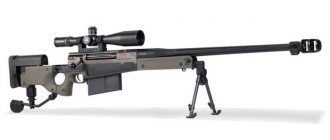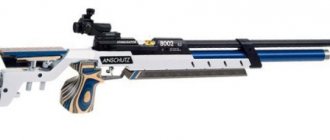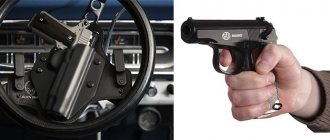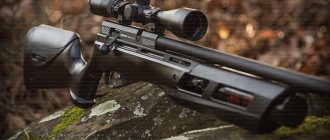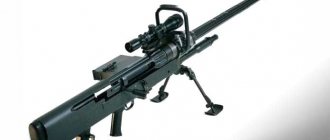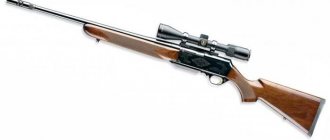History[edit]
After the development and successful combat use of the FN P90 submachine gun, FN began developing a self-loading pistol chambered for the same cartridge (5.7x28 mm). It was completed in 1995; however, special forces in Europe and the United States were in no hurry to adopt new weapons. Despite the high destructive power of the bullet, this pistol was considered frivolous and ineffective by venerable military experts. In 2000 alone, Cyprus police special forces purchased 250 FN-5-7 units. Later it was adopted by GIGN, the Belgian army and several special forces of small countries.
Automatic rifles FN FAL, FN CAL and FNC
In 1948, a group of engineers from the famous Belgian company from Herstal, under the leadership of designer Dieudonne Seve, began developing an automatic assault rifle chambered for a shortened cartridge. The experience of World War II suggested that weapons of this class were the future, and for the company, as one of the largest manufacturers of first-class small arms, re-equipping armies with automatic rifles promised huge profits. Of course, if the presented developments were successful.
Initially, it was decided to create a rifle chambered for the German 7.9233 mm cartridge from World War II, then the British .280/30 (7 mm) cartridge was adopted as ammunition. Finally, in 1951, a sample chambered for the experimental American cartridge T 65 E 3 caliber 7.62 mm appeared. This ammunition was soon adopted as the standard NATO cartridge. And the Belgian rifle received the official designation FAL (Fusil Automatique Legere - light automatic rifle). It was a stunning success! In 1953, the armies of Belgium, Canada and Australia, and at the beginning of 1954 of Great Britain, adopted the Fabrique Nationale rifle as standard weapons. Only six months later, Germany, Israel and New Zealand joined them. Then the rifle was officially put into service in more than 50 countries, and was used in more than 90 countries on all continents of the world and, with a total “circulation” of several million pieces, became one of the most popular assault rifles. Back in the mid-1980s. it was in service with almost half of these countries. The weapon was in service in Argentina, Australia, Austria, Barbados, Belgium, Brazil, Burundi, Great Britain, Chile, Cuba, Dominican Republic, Ecuador, Gambia, Germany, Ghana, Guyana, India, Indonesia, Ireland, Israel, Kampuchea, Kuwait, Liberia, Libya, Luxembourg, Malaysia, Morocco, Mozambique, Oman, New Zealand, Norway, Paraguay, Peru, Portugal, Singapore, South Africa and the United Arab Emirates, produced under license in Australia, Austria, Argentina, Brazil, Great Britain, Venezuela, Israel, India , Canada, Mexico, Nigeria and South Africa.
Read: Schmeisser StG 44 assault rifle
In Germany, the FN FAL rifle was designated G 1 (and was used until the advent of the G 3 rifle), in Great Britain and Australia - L 1, in South Africa - R 1, in Canada - CA 1, in Austria - StG 58. The American military tested the FN FAL under the designation T 48, but adopted the M 14 rifle. In several countries, the FN FAL was produced under license with minor changes in design.
Until recently, four modifications of the rifle were made:
— FN 50-00 — a standard army model with a permanent stock and a standard barrel, equipped with a diopter sight designed for a distance of up to 600 m; — FN 50-64 — version with a folding shoulder rest and a standard barrel, has a sight with a range of up to 250 m; — FN 5063 (FN “Para”) — an airborne modification with a folding shoulder rest, a shortened barrel and a fixed sight at 300 m; - FN 50-41 (FN HB) - a model with a permanent butt, a heavy barrel and folding bipods on the muzzle of the barrel, the weapon can be used as a light machine gun.
Currently, serial production of the rifle has been stopped due to the widespread use of smaller caliber weapons.
In 1957, based on the American hunting cartridge .223 “US Remington” (5.6×43 mm), a 5.56×45 mm caliber ammunition was created, which soon became, under the designation M 193, the cartridge of the new American M 16 automatic rifle, and then and standard NATO reduced caliber ammunition. Belgium was one of the first in the world (and the first Western European country) to follow the American example. Engineers created their own modification of the M 193 cartridge, designated SS 92. In 1967, an automatic rifle chambered for this cartridge appeared. The automatic action of the rifle was based on the use of the energy of powder gases. The weapon had a rotating bolt.
Read: Kalashnikov AK-47 (USSR-Russia)
In 1971–1974 An experimental series of Belgian rifles was tested in France under rather harsh conditions. After this, the weapon under the designation CAL (Carbine Automatique Legere - light automatic carbine) was adopted by some branches of the Belgian military and put into mass production, which, however, did not last long. In operation, the weapon proved to be short-lived and rather capricious; in addition, the cost of the rifle was high.
Soon serial production was curtailed, and the designers began to refine the “damp” design, which was greatly facilitated by the experience of production and operation of the FN CAL in the army. The bottlenecks of the rifle were identified - components and parts that required modernization. The technology for creating weapon mechanisms has also changed significantly. In 1975, work on modernizing the unsuccessful FN CAL was completed with the creation of the FNC model (Fabrique Nationale Carbine - FN carbine).
In April 1976, large-scale weapons tests took place within NATO, in which the Belgian company with its new development participated along with many leading manufacturers of small arms and ammunition. The tests were carried out with the aim of developing common requirements for weapons and ammunition for all member countries of the bloc. The NATO command planned to adopt a single weapon. These plans were not destined to come true, and today the armies of the leading NATO member countries mainly use weapons of their own production. During testing, almost all types of small arms caused some criticism, including the new Belgian rifle.
Read: Automatic “AUG”
This, however, did not stop the developers, and after eliminating a number of shortcomings, the weapon was again presented to the military and soon adopted by the Belgian army. The compact and lightweight FNC assault rifle is ideal for arming infantry units fighting in difficult terrain, separated from the main troops. Small dimensions make it convenient to use the rifle in confined spaces, for example, inside ground and air vehicles.
In 1981, a specially created modification of the FNC 80 under the designation AK-5 was adopted by the Swedish Army. Licensed production was also established in Indonesia - the Indonesian rifle received the designation SS 1 V. The Belgian company developed a shortened version for arming the police and intelligence services. Such weapons under the designation FNC 70-30 were supplied to the United States to arm police officers, and later the American purchased the rights to produce these weapons.
The FNC rifle turned out to be a fairly effective and reliable weapon, which, however, did not receive such distribution as the very successful FN FAL. Currently, the FNC rifle is produced in limited quantities and is in service in several countries in Europe, Asia and South America.
You might be interested:
- Rifle "FN FAL"
- M16 rifle
- M1 Garand rifle
- Winchester rifle
- History of automatic weapons
- Lee-Enfield rifles
Subscribe to
our channel in Yandex.Zen
Construction[edit]
Five-seveN is a full-size semi-blowback semi-automatic pistol that uses 5.7x28mm cartridges. Polymers are widely used in its construction. The total length of the pistol is 208 mm. The barrel is made by cold forging, chrome-plated, 122 mm long, weighs 113.4 g, the length of the rifled part is 94 mm. The barrel has 8 right-hand rifling with a pitch of 1:231 mm. Claimed service life is 20,000 rounds. Weight 617 g without cartridges or 744 g loaded. The maximum thickness of the gun is 36 mm. Despite the considerable length of the 5.7x28 mm cartridge used in the Five-seveN, the distance from the trigger to the butt plate is 69.85 mm, which is exactly the same as that of the Beretta 92 pistol.
The modern version of the Five-seveN USG has a single-action trigger with a trigger force of 2 to 3 daN (approximately 2-3 kg). The pistol has an M1913 Picattini rail, and the magazine safety mechanism prevents it from firing if the magazine is removed. The height of the pistol is 145 mm with standard adjustable sights. The handle is knurled and has a series of narrow serrations on each side of the bolt housing for a more secure grip. The trigger and guard are also checkered to prevent finger slipping, and the trigger guard is enlarged to make shooting with gloves easier. The pistol is currently offered in two frame finishes, in addition to the usual black - FDE (Flat Dark Earth) and ODG (Olive Drab Green). Beginning in 2009, it is also offered with low-profile fixed sights in addition to the standard adjustable ones.
